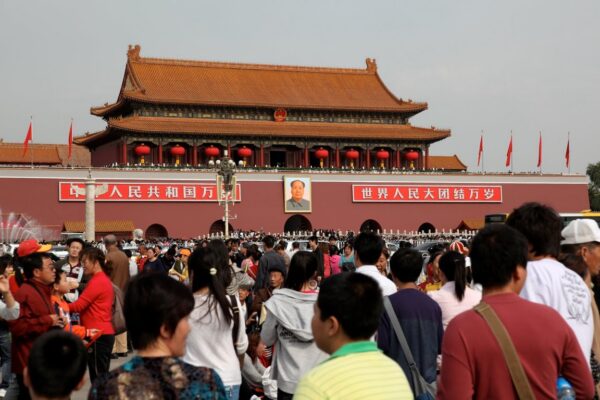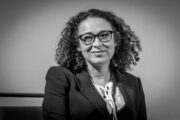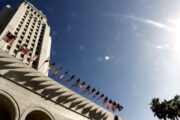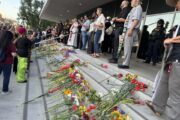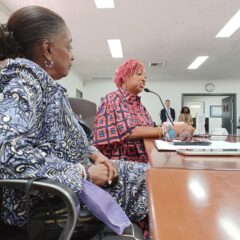CRCC Managing Director Brie Loskota delivered the following as her concluding keynote address at the 8th Annual American Studies Network Conference at Northeast Normal University in Changchun, China, in September.
Download “Religion’s Uneasy Place.” (PDF)
This paper explores the complicated roles of religion in the American public square and as a form of soft power in international diplomacy. First, this paper will briefly review the First Amendment of the United States Constitution, which guarantees and protects freedom of religion, fostering enormous religiosity and religious diversity in the U.S., while also constraining government engagement with religion. It will also provide an overview of the roles religion plays within the United States. It will show that all levels of the United States government have become more interested in religion for a variety of reasons and discuss the complicated nature of this increased interested in engagement and partnership. While the United States has this interest in religion domestically it has yet to work through the Constitutional and pragmatic issues of religious engagement. The inability of the United States to grapple with religion effectively within the country hampers its ability to create a successful program for international religious engagement. Thus, the focus on freedoms that gives birth to the religiously pluralistic American public square simultaneously diminishes the effectiveness of U.S. government efforts to tap the power of religious values, institutions, and actors in international affairs precisely because they do not want to violate the Establishment Clause of the First Amendment.
Religious freedom, a hallmark American value afforded by the First Amendment of the United States Constitution, is the basis of much of the nation’s stance toward religion both at home and abroad. Over and above religious freedom, the U.S. has accommodated and engaged with religion¬—and religious institutions—with increased interest. This increased engagement has not gone uncontested. With the advent of the “Religious Right,” Charitable Choice, President Bush’s Faith Based Initiative, and President Obama’s Office of Faith Based and Neighborhood Partnerships, new and ambiguous space has been opened up domestically around government engagement of and partnership with religious groups. Indeed, the U.S. has a conflicted relationship with religion as a public actor. On one hand, Americans are highly religious, yet on the other they believe that religious leaders should have less direct involvement in politics. This conflicted view is manifested in a variety of ways, for example, religious groups and others initially opposed Charitable Choice legislation, over fears that government bodies would dictate religious doctrine. This initial resistance has largely faded.
As the U.S. grapples with the proper place for religious engagement within its borders, it also faces similar issues abroad. For example, agencies like the U.S. Department of State must continually wrestle with a shifting idea of what American religious engagement look like with international and transnational publics. The U.S.’s inability to fully conceptualize how to engage religion at the domestic level has led to confusion about the limits and permissions for international religious engagement. Moreover, diplomats and other officials often have not been trained about religions in the fields where they will operate and religious engagement is seen as less of a priority than religious freedom. As a result, international engagement work by government agencies leaves much to be desired. In fact, non-governmental organizations (NGOs) operate with greater latitude and are able to navigate this arena with greater success. Thus, the First Amendment, America’s greatest asset to preserve religious freedom, also functions as a stumbling block when considering religious engagement both at home and abroad.
Establishing Domestic Religious Freedom
The First Amendment of the United States Constitution states, “Congress shall make no law respecting an establishment of religion [the Establishment Clause], or prohibiting the free exercise thereof [Free Exercise]; or abridging the freedom of speech, or of the press; or the right of the people peaceably to assemble, and to petition the government for a redress of grievances.” Together, the two ideas—the Establishment Clause and Free Exercise—along with the long history of the interpretation of these ideas, and the state and federal statutes that have been enacted to give legal parameters to them, form the basis of American understanding of the place of religion in society. While scholars of American legal history have lengthy debates and a rich discourse about the meaning and interpretations of the First Amendment, this paper will not examine those areas but instead focus on the social outcomes that result from grappling with the First Amendment’s guarantees and limits on religion.
The Place of Religion in American Society
Religious Institutions. America has evolved a system of state noninterference with religion—the so-called neutrality principle. There is no official state run religious body. Religious organizations can freely operate without state permission, and groups are even free to develop new religious movements with outlandish theologies or truth claims that may be seen as hostile to the state interests, at least in theory. The courts have protected religious groups from state interference in religious matters, though a case recently heard before the United States Supreme Court, Hosanna-Tabor Evangelical Lutheran Church and School v. EEOC, tested the way that the court construes the “ministerial exception” and found that religious groups have broad discretion when defining job descriptions as religious in nature. The Supreme Court for “first time recognized a “ministerial exception” to employment discrimination laws, saying that churches and other religious groups must be free to choose and dismiss their leaders without government interference.” The government stance toward religious bodies has been to ensure that they avoid entanglements in cases that require judgments to be made on matters of theology or doctrine.
Individual expression of religion. Religion for individuals is protected from discrimination and undue burdens. Laws about religious accommodation in religious dress, observance, and even the ability to object to certain work or civil duties, though occasionally contentious, are well established. Individual freedom of conscience has been protected beginning with conscientious objector status for pacifists during the American Revolution. Today, the right remains protected to the extent that pharmacists can refuse to fulfill prescriptions for contraception based on their religious objections.
This posture against establishing religion and protecting religious freedom by the state has helped to create, either by default or design, an enabling environment for religion to flourish in American society. Americans are more religious than other members of western industrialized nations and there are nearly 350,000 congregations in the United States. In Los Angeles alone, there are over 8,500 faith-based institutions (mainly congregations and nonprofit organizations). This number does include less formal groups that do not have their own permanent physical space or groups who are not registered as non-profit organizations for tax purposes. There is a marketplace of religious life in the United States that is attractive to many immigrant groups, especially those fleeing religious persecution in their countries of origin.
Opportunities and limits on religion in the public sphere. But religion in the U.S. is neither an entirely private affair, nor a new phenomenon. There has always been a role for religion in the U.S. that is neither entirely private, nor entirely political: the so-called third space—the public square or civil society. This space, and religion’s role in it, is still being grappled with, contested, and formed, especially as civil society in the U.S. is increasingly politicized and some scholars argue religion is being deprivatized in light of the failure of secularization.
America is permeated by religious vocabulary and appeal to values in public and even overtly political discourse. Religious institutions, leaders, and followers have played roles in every major political movement in the United States, and have been on every side of those issues, from supporting to abolishing slavery, to women’s suffrage, and civil rights for African Americans.
Religion in the United States occupies an important place in the public square. Despite scholarship and surveys noting the decline of religion in many industrialized countries, the United States remains highly religious both in terms of attendance at services and in individual beliefs and practices related to religion and spirituality.
Yet, Americans are split about their views of religious leaders taking explicit roles in politics. Even among conservatives, a growing number are skeptical of religion’s active role in the political arena. “The new national survey by the Pew Research Center reveals that most of the reconsideration of the desirability of religious involvement in politics has occurred among conservatives. Four years ago, just 30% of conservatives believed that churches and other houses of worship should stay out of politics. Today, 50% of conservatives express this view.” Many religious leaders have had failed, stunted, or short-lived political careers; being a religious leader is no guarantee of a successful political following. Tax codes that enable religious institutions to be exempt from taxes also bar congregations and leaders from endorsing candidates from the pulpit. Religious institutions often walk a fine line between advocating for policies or change based on their religious convictions and explicitly engaging in partisan politics.
That line has been complicated in the last few decades. With the rise of the Religious Right, the 1996 Welfare Reform Act with its Charitable Choice provisions, and the subsequent creation of the White House Office of Faith Based Initiatives (2001) and the Office of Faith Based and Neighborhood Partnerships (2008), formal associations between religious and government bodies have increasingly become the norm. Blurring the aforementioned thin line, religious groups have become potential recipients of federal (and state and local) funds, which has led to a contentious debate as these developments have created a new relationship for faith groups vis-a-vis the government. Some view this era as one characterized by the state no longer being neutral, but explicitly endorsing religion by providing the opportunity for funding to religious organizations. Others would argue that the government remains neutral because favoritism for any particular religion or religious organization does not exist, but simply openness to funding available to all religions and religious groups. In 1996, the removal of the barriers to federal funding for religious groups began this new environment of engagement of religious groups to carry out social services and specific policy aims. This was met with confusion by religious groups as to the limits on religious activity that could be undertaken while receiving public funds, and hostility by civil liberties groups that viewed this as a violation of the Establishment Clause of the First Amendment. It raised questions regarding what was permissible now that religious bodies could compete for federal dollars.
While the opposition to federal funding for faith-based social services has largely diminished from American public discourse, the nuts and bolts of how exactly religion should engage the state remains disputed area for both religious groups and public entities. A recent Illinois court case that barred Catholic Charities from discriminating against same sex couples in adoption services when they take public funds placed Catholic Charities in the position of having to decline public funds if they continued to discriminate based on their theological positions. Eventually, Catholic Charities dropped their lawsuit challenging the rule and closed their Illinois offices. This is an example where competing interests and these foundational legal principles find themselves in a tangled web.
This web is still being negotiated by national and local governments in the United States. In fact, in a recent conversation with a local county department in Los Angeles, I discussed their clergy outreach programs. During the course of the meeting, when I suggested that they ask clergy to share a sacred text on the subject at hand, I received horrified responses that such activity would not be allowed in a government building. From the perspective of this local government agency, outreach to religious groups was acceptable, but discussions related to their core beliefs and sacred texts were off limits. This is a prime example of confusing current environment facing public agencies and religious groups in their relationships.
In fact, this situation is not uncommon. Given the relatively new position of the U.S. government providing increased access to public funds to faith organizations, local and state governments have sought to implement the spirit of these initiatives by developing faith outreach and liaison programs and positions in nearly every agency and department. There are countless local faith based liaisons whose job it is to conduct outreach and engagement to faith groups on every issue from emergency preparedness to working with educational institutions on student performance, countering violent extremism, to coordinating mental health care. These liaisons receive almost no training on faith groups and congregations when they take their jobs. They often lack cultural competency, and very few have the power to influence policy or make funding decisions.
How Domestic Policy Impacts International Public Diplomacy
Like many experts have noted, domestic constructions and values are the basis for shaping and understanding the international concerns of a state. Not surprisingly, American government work abroad has primarily focused on pushing notions of religious freedom, even creating bodies, enacting laws and issuing reports on the global state of religious freedom. President Barack Obama noted that, “At home, we vigorously protect the civil rights of Americans, regardless of their religious beliefs. Across the globe, we also seek to uphold this human right and to foster tolerance and peace with those whose beliefs differ from our own.”
Yet religious freedom is just one aspect and strength of the United States. The vibrant religious pluralism of American society, however flawed and marred by acts of intolerance, is also an asset. Indeed it is the output and outcome of religious freedom (free exercise and the lack of establishment of state sponsored religion). “Religious freedom provides a cornerstone for every healthy society,” notes Secretary of State Hillary Rodham Clinton. “It empowers faith-based service. It fosters tolerance and respect among different communities. And it allows nations that uphold it to become more stable, secure and prosperous.” It would make sense for the U.S. to trumpet religious engagement as another hallmark strength by working with religious leaders and religious institutions in public diplomacy and engagement. This trumpeting of religious engagement is a tremendous opportunity for the exercise of soft power, appealing to shared values as way to attract foreign publics and even governments to U.S. interests.
There is a growing awareness that religious engagement is a complimentary strategy employing soft power in trying to achieve U.S. policy aims. In a 2002 Foreign Affairs article, Peter Peterson noted the need for this work would “create bridges between American society and other societies using common cultural pursuits in every genre of art, music, theater, religion and academic.”
Though fully comfortable discussing and pushing for religious freedom, agencies like the Department of State and USAID are continually grappling with identifying the precise nature of American religious engagement looks like with international and transnational publics. Indeed, the United State’s inability to fully conceptualize this domestically has led to confusion about the limits and permissions for religious engagement internationally. In fact, the Obama Administration’s Advisory Council on Faith-based and Neighborhood Partnerships recommended the launching of the Interagency Working Group on Religion and Global Affairs to better understand and coordinate how religious communities are engaged in international affairs.
In general, diplomats and other officials are ill prepared for engaging religious leaders, institutions, and publics around the globe. They receive almost no mandatory training in the necessary religious literacy and competency required to navigate their difficult assignments. This lack of instruction combined with the general American religious illiteracy means that the nation is sending representatives out into a very religious world without the tools necessary to operate effectively. In a 2009 article in Middle East Policy, Peter Krause and Stephen van Evera noted that “few U.S. officials know enough about Islamic law and theology, or about Muslim-world history and culture to debate relevant issues. As a result they are rarely persuasive on questions that shape Arab/Muslim political opinion”.
Part of this is due to the nature of religious engagement.
Like much of public diplomacy, it is harder to assess and benchmark the impact of outreach efforts. Religious freedom is easier to measure and there is a vocal domestic lobby—including many conservative Christian organizations—that push the United States to ensure increased global religious freedom. Engaging with religious leaders, institutions, actors and messages, however, falls into a subcategory of public diplomacy, which itself has to compete for attention, strategic prioritization, and funding against other approaches within an underfunded State Department. It also requires making religious judgments, using religious language, and choosing with whom to engage. This of course is something that the U.S. government does with great difficulty and when it does so, however occasionally, it is met with mixed results.
One example was the world tour by an imam that the U.S. considered a pillar of America’s culture of religious pluralism and interfaith engagement. The imam was sent to discuss the American Muslim experience with Muslim religious leaders and publics. He was very well known in interfaith circles, but had limited following in mainstream American Muslim communities and is not considered an authoritative figure by those communities. However, he was trumpeted as an ideal leader who bridged both worlds: Muslim and Western (as if this dichotomy was real). He was sent on two tours under the Bush administration and two under the Obama administration, the last of which was in August 2010. This last 15-day trip took place during the height of the Park51 issue, a project that became a lightning rod for protests against developing an Islamic center near Ground Zero in Manhattan. The United State’s public diplomacy showcasing American religious freedom, pluralistic flourishing, and the social equality of the Muslim community was complicated by a very public and very hostile debate about mosques, Muslims and Islam in America. It was further complicated by the fact that the imam on the tour was Imam Faisal Abdul Rauf, who was at the time the spiritual leader of Park51.
Conclusion
Perhaps it is better than that much of the best work in this area is actually done not by official government bodies or at the invitation of departments, like the Department of State, but by NGOs, since they operate with greater latitude than federal agencies. Doug Johnston’s International Center for Religion and Diplomacy (www.icrd.org) and Chris Seiple’s Institute for Global Engagement (www.globalengage.org) are two examples of track two diplomacy efforts that operate out of their own faith commitments on global religious engagement and work across religious divides. This work has work has led to some tremendously valuable outcomes, including advancing the Sudanese peace process and diminishing anti-Americanism in central Asian madrasas. They may in fact serve as heat shield that allows the U.S. to have representation on difficult issues without the negative exposure or political repercussions that come from official government-sponsored involvement.
This work is beginning to be done by U.S. government bodies and diplomats, who realize that doing so could strengthen the attractiveness of the U.S. by leveraging its strong position as a beacon of religious flourishing, in addition to a beacon of religious freedom in a highly religious world. Despite having many shining examples of diplomats and departments working with faith communities abroad, a conference on those efforts put on by the State Department, “found that much of our outreach was sporadic, focused primarily on ceremonial events, and all too often ad hoc and uncoordinated. Based on the success of last week’s seminar, we will be integrating trainings on faith-based partnerships into other parts of our regular curriculum, and we are also pursuing new policy guidance and legal guidelines to give our diplomats greater clarity about engaging faith communities abroad.” Despite the acknowledged desire to do religious engagement work, and even the efforts already underway, and actual work on the ground is complicated by a lack of guidance about what is permissible, clarity about the objectives and training to successfully operate in the field.
Thus, America’s greatest asset in terms of securing religious freedom in the U.S. (the First Amendment) hampers religious engagement both at home and abroad. Ironically, the greatest American tool that lays the groundwork for the its religious pluralism because of state non-interference with religion, makes fully engaging with international religious institutions, actors, public, and beliefs problematic for American official to fully undertake and exploit.
Brie Loskota is the former executive director (2016-2021) of the USC Center for Religion and Civil Culture.
